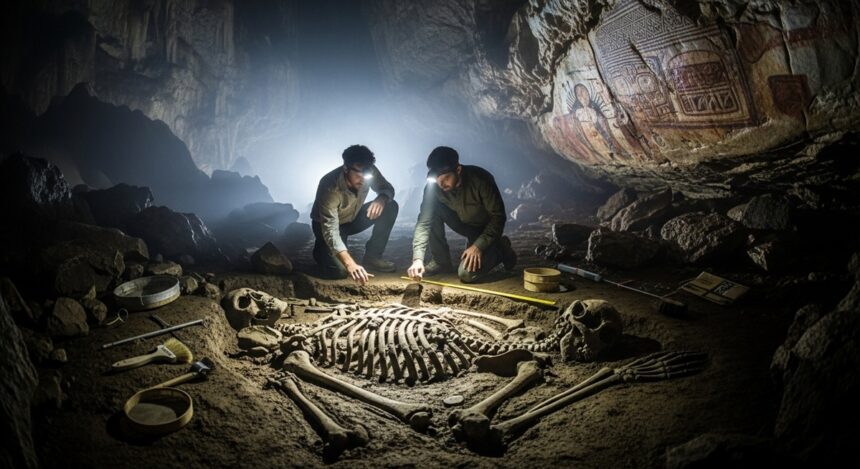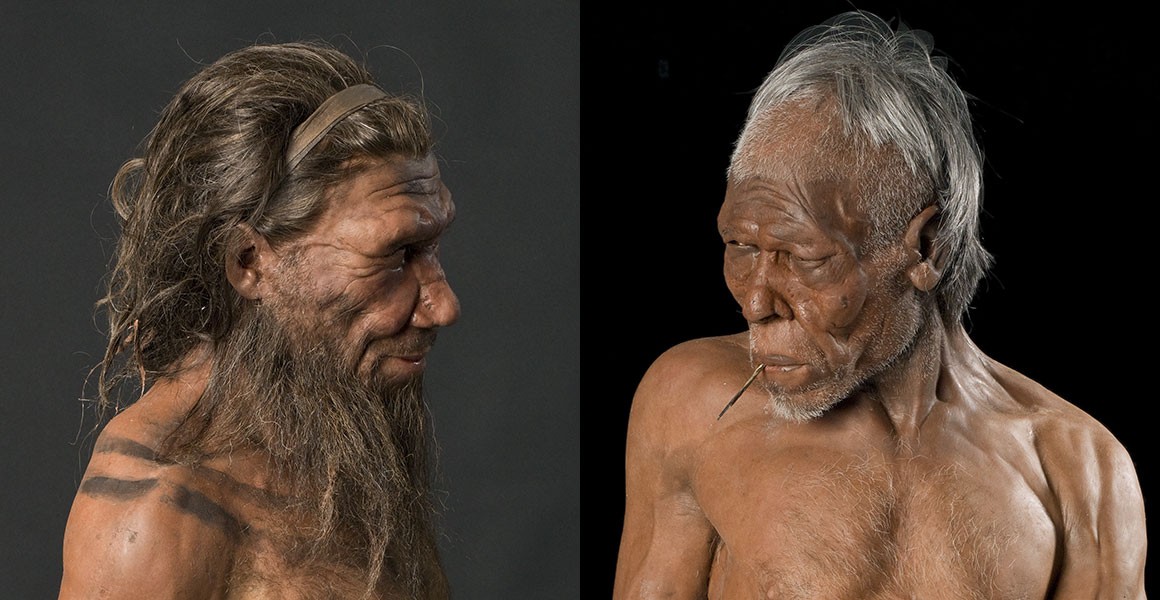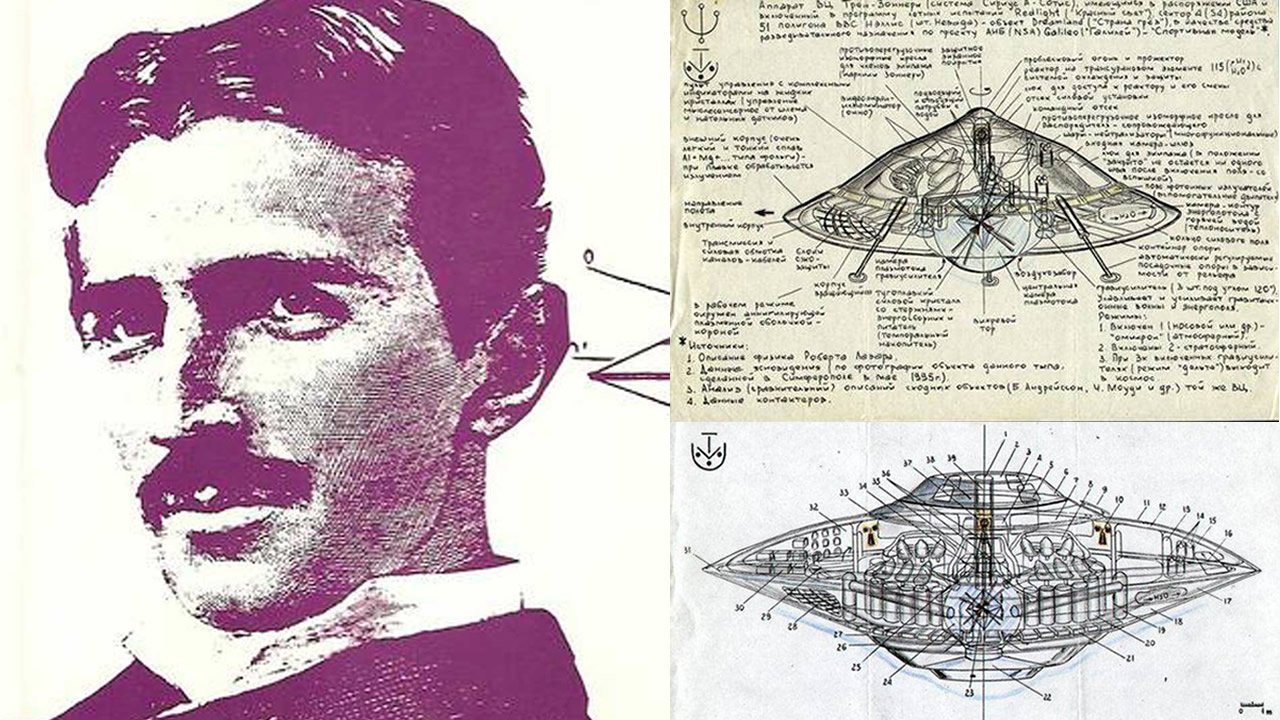Imagine digging into the misty caves of northern Ecuador, expecting to find the remnants of an ordinary ancient civilization, only to stumble upon bones that whisper secrets from another world. That’s exactly what happened when two tenacious American geneticists turned a routine investigation into a five-year odyssey of revelation. Their findings? A species of ancient humans whose DNA holds a staggering secret: 17% of DNA does not belong to humans. This is the groundbreaking work of Edwin Ryder and Josh Simpson, who have ignited a firestorm in the scientific community.
In a world where ancient human remains often rewrite textbooks, this Ecuadorian enigma stands apart. Discovered in caves dating back 28,000 years, these skeletons aren’t just old—they’re anomalous. Taller, stronger, and intellectually advanced, their genetic makeup defies natural explanation. Could this be evidence of genetic intervention from beyond Earth? Or is it a puzzle of evolution we’ve yet to solve?
The Spark That Ignited a Scientific Quest
It all began with whispers from local archaeologists in Ecuador, a land rich in pre-Columbian mysteries. They claimed to have unearthed evidence of an unknown ancient species that roamed South America millennia ago. The scientific world, ever cautious, dismissed these reports as exaggerated folklore. But Edwin Ryder and Josh Simpson, seasoned geneticists from the United States, weren’t ones to ignore a potential breakthrough. What started as a brief fact-finding trip stretched into over five grueling years of fieldwork, transforming skepticism into astonishment.
These aren’t your average lab-coated researchers. Ryder, with three decades of experience in genomics, has a reputation for unraveling the most tangled evolutionary threads. Simpson, carrying on his father’s legacy in ancient DNA studies, brings a fresh yet rigorous eye to paleogenetics. Together, they bridged the gap between dusty artifacts and cutting-edge molecular biology, proving that true discovery demands both curiosity and endurance.
Ecuador’s Hidden Caves
Ecuador’s northern regions, shrouded in lush jungles and jagged Andes foothills, have long been a treasure trove for archaeologists. But this wasn’t about Inca gold or lost cities but bones buried in seclusion. The team focused on a cluster of caves, isolated pockets that seemed to cradle a forgotten community. No similar remains have surfaced elsewhere in the Americas, adding an layer of intrigue. Why here? Why now? As the geneticists sifted through the earth, they uncovered over 300 skeletal fragments, each telling a story of a people who thrived in isolation, perhaps guarding secrets we can scarcely imagine.
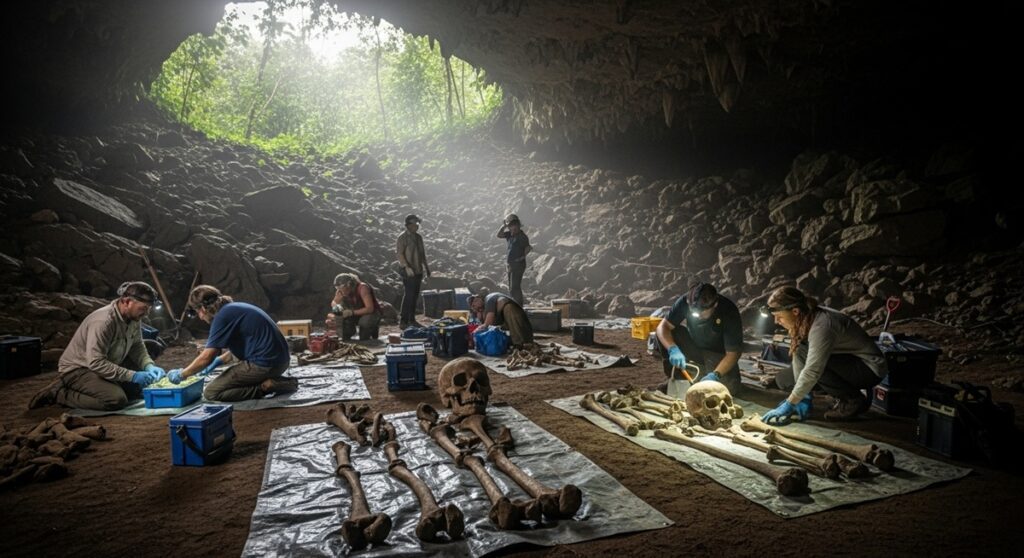
Local lore spoke of giants or enlightened beings who predated even the Incas, but Ryder and Simpson approached it with empirical zeal. Armed with shovels, spectrometers, and sequencers, they documented every layer of soil, ensuring their work withstood the scrutiny of peers. This meticulous excavation wasn’t just about quantity—it was about quality, yielding intact skulls and long bones that promised profound insights.
Decoding the Physical Enigma: Skeletons That Defy the Norms
As the bones emerged from the damp cave floors, the physical differences became impossible to ignore. These weren’t the frail frames of typical Ice Age nomads. Standing at an estimated 180 centimeters or more—towering over the average 150-160 centimeters of contemporaneous humans elsewhere—these individuals exuded an aura of superhuman vitality.
Brains, Bones, and Brawn: What the Skeletons Reveal
One of the most striking features was the cranial capacity. The skulls housed brains larger than those of modern Homo sapiens, suggesting cognitive prowess that rivaled or exceeded our own. Yet, anatomically, they mirrored us perfectly—no protruding brow ridges like Neanderthals, no robust jaws reminiscent of Cro-Magnons. This species bridged the archaic and the contemporary, a seamless evolution that puzzled anthropologists.
But it was the bones themselves that truly baffled. Analysis showed mineralization levels 2.5 to 3 times denser than in ordinary human remains. We’re talking about structures engineered for endurance, not just survival. Nutrition alone couldn’t explain it; no amount of mineral-rich diet could hyper-concentrate calcium and phosphorus like this. The body would need an innate mechanism to absorb and distribute these elements with uncanny efficiency, a trait more akin to reinforced steel than fragile organic matter.
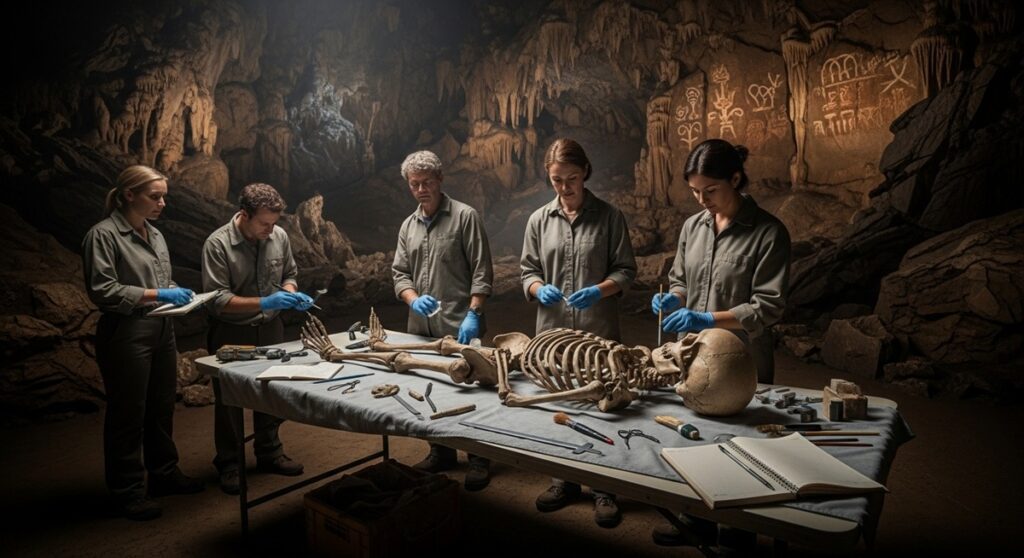
Anthropologists on the team speculated that these people possessed not only physical might but intellectual depth. Cave art nearby, etched with complex symbols, hinted at advanced communication or even proto-writing. Were they philosophers in the wild, strategists outpacing their northern neighbors in Mexico and beyond? The isolation in those Ecuadorian caves suggests a deliberate enclave, perhaps a refuge or experiment gone awry in the annals of time.
The Genetic Bombshell: 17% Alien to Earth?
If the physical findings were intriguing, the genetic analysis was earth-shattering. What began as routine sequencing in makeshift jungle labs escalated to international collaboration. The results? Only 83% of the DNA aligned with known human profiles. The remaining 17%? Utterly foreign—no matches to any terrestrial organism, human or otherwise.
Dissecting the DNA: Haplogroups and the Unexplained
Diving into the numbers, 82.9% of the genome tied to haplogroup C-L1373, a marker linked to ancient South American lineages—predecessors to indigenous groups like the Quechua or even Inca forebears. This grounded the sample in human history, evoking images of resilient migrants crossing Beringia or sailing forgotten seas. But that pesky 17.1%? It formed no known haplogroup. No mutations, no hybrids—just a genetic wildcard that shouldn’t exist.
Ryder, poring over chromatograms late into the night, described it as “something incredible.” In his 30 years, he’d seen chimeras and contaminants, but never this. “The basis is undoubtedly human, characteristic of local residents from antiquity,” he noted. “But these extra genes? They’re not from our planet’s playbook.” He likened the anomaly to artificial tampering, dismissing natural selection as the culprit. Mutations tweak; they don’t overhaul 17% of a genome overnight.
Voices from the Frontlines: Ryder and Simpson Speak Out
Edwin Ryder’s candid reflections capture the raw excitement and frustration. “Based on numerous laboratory tests, I have the impression that we have found something incredible,” he shared. “In my 30 years of work, I have never seen something like this.” He emphasized the human core, tying it to “the predecessors of the Quechua or pedestal” (perhaps a nod to ancient pedestal cultures in Andean lore). Yet, the strength and stature screamed enhancement. “Figuratively speaking, no matter how much you feed a caveman with dietary supplements, his body won’t absorb minerals at these levels.”
Josh Simpson echoed the sentiment, drawing from his family’s deep roots in paleogenetics. “I specialize in the study of ancient human DNA,” he explained.
“My father did it, and I followed in his footsteps. In my experience, something extraordinary happened here in the jungles of Ecuador tens of thousands of years ago.”
He consulted U.S. colleagues, who ruled out spontaneous mutation.
“Mutations aren’t able to replace 17% of the genome,” they agreed.
Instead, Simpson sees deliberate modification—data sent to top labs for validation, hoping fresh eyes spot what the duo missed.
Theories That Push the Boundaries: Intervention or Illusion?
So, what does this mean for our understanding of human evolution? The scientific community buzzes with debate. On one hand, skeptics cry contamination—perhaps bacterial overgrowth or sequencing errors. But Ryder and Simpson’s protocols were ironclad, with samples cross-verified in multiple facilities. The bones are en route to the U.S. for deeper scrutiny, a move born of necessity:
“I am convinced that no one will believe us” without it, Ryder admitted.
The Alien Hypothesis: Fact or Fringe?
Enter the tantalizing theory: extraterrestrial genetic engineering. If not mutations, then what? Artificial intervention implies visitors from afar, tweaking a small group’s genome for reasons unknown—enhanced strength for labor? Intellectual leaps for societal advancement? It’s a stretch, but the evidence nags. These cave-dwellers, with near-modern smarts and Herculean builds, lived 28,000 years ago, predating known advanced cultures. Did they arrive via ancient migrations, or were they “seeded” here?
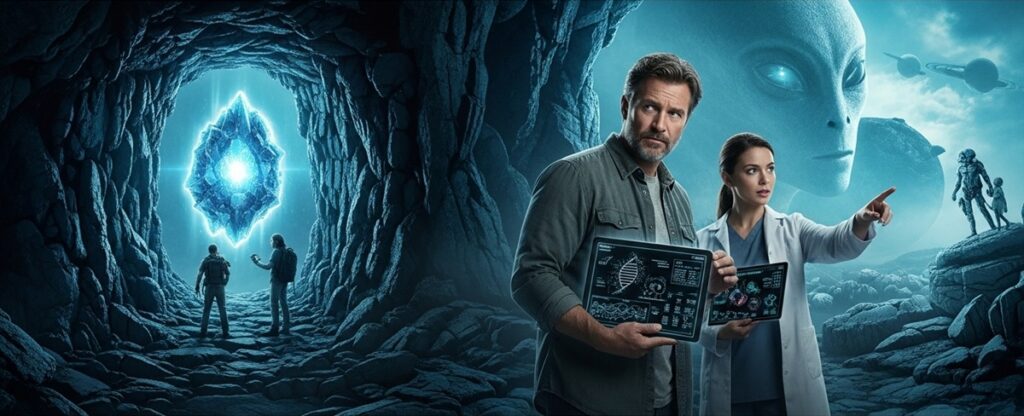
History brims with such riddles: the Antikythera mechanism, Göbekli Tepe, even Sumerian texts of star gods. This Ecuador discovery slots right in, challenging the linear narrative of Darwinian progress. Simpson muses, “I have already talked to colleagues… they unequivocally state that mutations are not able to replace 17%.” The duo remains grounded, but the possibility lingers: “So far, it is hard to believe that representatives of other civilizations… conducted genetic experiments.” Yet, in a universe of infinities, why not?
Broader Implications for Science and Society
Beyond the labs, this ripples outward. If confirmed, it upends anthropology, suggesting human origins involve more than ape ancestors and environmental pressures. It invites ethical quandaries: Who owns this DNA? Indigenous Ecuadorians? Global science? And practically, could we harness that 17% for medical miracles—stronger bones against osteoporosis, sharper minds against dementia?
The expedition also spotlights Ecuador’s role in global heritage. Northern caves, once overlooked, now demand protection. Collaborations with local experts underscore decolonizing archaeology, letting source communities lead the narrative.
The Quest Continues
As Ryder and Simpson await U.S. lab verdicts, the world watches. Will this 17% non-human DNA prove a hoax, a breakthrough, or a paradigm shift? One thing’s certain: it reminds us that history’s pages are still turning. In the shadows of Ecuador’s caves, humanity’s story grows weirder, wilder, and wonderfully unresolved. Stay tuned, this could be the spark that lights up our collective future.







